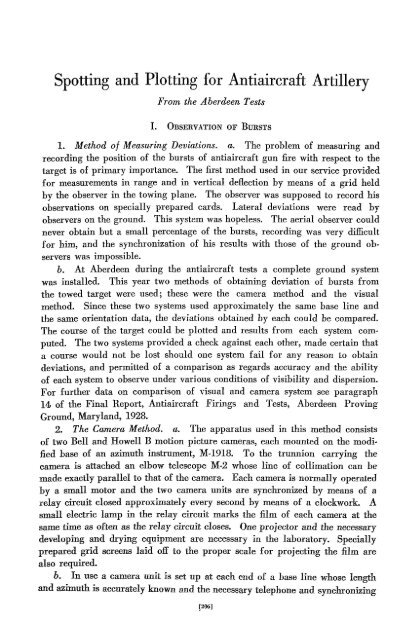THE COAST ARTILLERY JOURNAL - Air Defense Artillery
THE COAST ARTILLERY JOURNAL - Air Defense Artillery
THE COAST ARTILLERY JOURNAL - Air Defense Artillery
You also want an ePaper? Increase the reach of your titles
YUMPU automatically turns print PDFs into web optimized ePapers that Google loves.
Spotting and Plotting for Antiaircraft <strong>Artillery</strong><br />
From the Aberdeen Tests<br />
I. OBSERVATION OF BURSTS<br />
1. Method of Measuring Deviations. a. The problem of measuring and<br />
recording the position of the bursts of antiaircraft gun fire with respect to the<br />
target is of primary importance. The first method used in our service provided<br />
for measurements in range and in vertical deflectionby means of a grid held<br />
by the observer in the towing plane. The observer was supposed to record his<br />
observations on specially prepared cards. Lateral deviations were read by<br />
observers on the ground. This system was hopeless. The aerial observer could<br />
never obtain but a small percentage of the bursts, recording was very difficult<br />
for him, and the synchronization of his results with those of the ground ob.<br />
servers was impossible.<br />
b. At Aberdeen during the antiaircraft tests a complete ground system<br />
was installed. This year two methods of obtaining deviation of bursts from<br />
the towed target were used; these were the camera method and the visual<br />
method. Since these two systems used approximately the same base line and<br />
the same orientation data, the deviations obtained by each could be compared.<br />
The course of the target could be plotted and results from each system computed.<br />
The two systemsprovided a check against each other, made certain that<br />
a course would not be lost should one system fail for any reason to obtain<br />
deviations, and permitted of a comparison as regards accuracy and the ability<br />
of each system to observe under various conditions of visibility and dispersion.<br />
For further data on comparison of visual and camera system see paragraph<br />
14 of the Final Report, Antiaircraft Firings and Tests, Aberdeen Proving<br />
Ground, Maryland, 1928.<br />
2. The Camera Method. a. The apparatus used in this method consists<br />
of two Bell and Howell B motion picture cameras, each mounted on the modi.<br />
fied base of an azimuth instrument, M-1918. To the trunnion carrying the<br />
camera is attached an elbow telescope M-2 whose line of collimation can be<br />
made exactly parallel to that of the camera. Each camera is normally operated<br />
by a small motor and the two camera units are synchronized by means of a<br />
relay circuit closed approximately every second by means of a clockwork. A<br />
small electric lamp in the relay circuit marks the film of each camera at the<br />
same time as often as the relay circuit closes. One projector and the necessary<br />
developing and drying equipment are necessary in the laboratory. Specially<br />
prepared grid screens laid off to the proper scale for projecting the film are<br />
also required.<br />
b. In nse a camera unit is set up at each end of a base line whose length<br />
and azimuth is accurately known and the necessary telephone and synchronizing
















